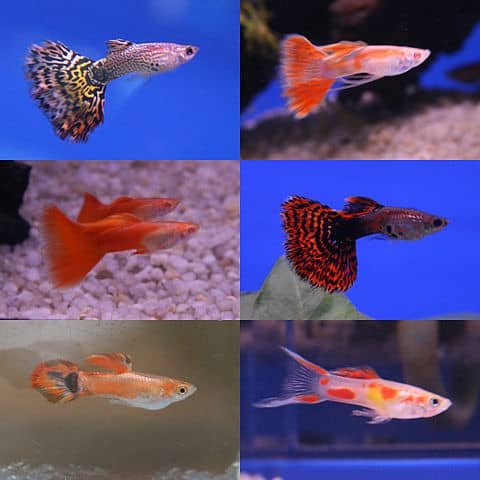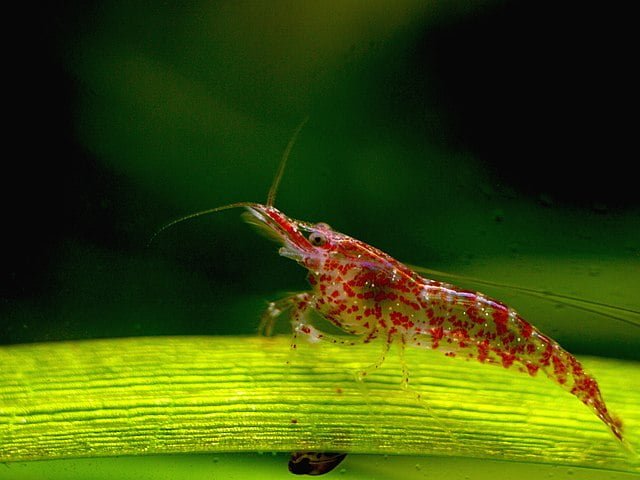The Endler Guppy (Poecilia wingei), also known as “Endler’s livebearer,” is a small freshwater fish native to Venezuela. It is famous in the world of aquarium hobbyists for its vibrant colors and peaceful behavior, making it a popular choice for both beginner and expert aquarists.
When it comes to caring for the Endler Guppy, enthusiasts are often captivated by the vitality and beauty these fish bring to their aquariums. Whether you are an experienced aquarist or just starting out, understanding the nuances of Endler Guppy care is essential to ensure their well-being and longevity.
In this comprehensive guide, we will explore everything you need to know about the Endler Guppy.
What is an Endler Guppy?
The Endler Guppy is a fish of the Poeciliidae family, closely related to the Guppy (Poecilia reticulata). Both species share characteristics such as viviparity (giving birth to live offspring) and ease of care.
On average, Endler Guppies have a lifespan of around 2 to 3 years under optimal conditions. Factors such as diet, water quality, and genetics play a significant role in determining lifespan. Providing proper care and attention can help maximize their lifespan and the enjoyment of aquarists.
The taxonomy of the Endler Guppy is as follows:
- Kingdom: Animalia
- Phylum: Chordata
- Class: Actinopterygii
- Order: Cyprinodontiformes
- Family: Poeciliidae
- Genus: Poecilia
- Species: Poecilia wingei (Poeser, Kempkes, & Isbrücker, 2005)
- Common name in Spanish: Guppy Endler, Guppy de Campona
- Common name in English: Endler Guppy, Endler’s livebearer
Origin and Characteristics
Endler Guppies are native to freshwater and brackish waters in the Campoma-Carúpano region, Paria Peninsula, and the Cumana region in Venezuela (Schories et al., 2009). They are characterized by their small size (males up to 2.5 cm, females up to 4.5 cm) and vibrant colors, especially in males. Females tend to have more subdued coloration.

Endler Guppy vs Guppy: Key Similarities and Differences
Păpuc et al., (2022) reports that for a long time, the Endler Guppy was considered to belong to the guppy species Poecilia reticulata (Peters, 1859); however, Poeser et al., (2005) argue that they are distinct species due to differences in morphology, as well as differences in genetics (Morris et al., 2018) and behavior.
Stay Always Informed
Join our communities to instantly receive the most important news, reports, and analysis from the aquaculture industry.
Similarities
- Both are freshwater fish.
- They are viviparous.
- They are relatively easy to care for.
Differences
- Size: Endler Guppies are generally smaller and slimmer than guppies, with a more pointed caudal fin.
- Coloration: Endler Guppies have a greater variety of colors and patterns, and males display an intricate pattern of spots and stripes.
- Behavior: Endler Guppies are more active.
- Habitat: Endler Guppies prefer cooler waters with higher flow.
Guppy Hybridization
The topic of hybridization often sparks debate among aquarists, especially regarding Endler Guppies. While hybridization between Endler Guppies and traditional Guppies is possible, it’s essential to understand the potential implications.
In this regard, Vila-Pouca et al., (2022) compared the performance of female guppies (Poecilia reticulata), Endler guppies (Poecilia wingei), and their experimental hybrids in color association and reversal learning tasks, and found that hybrids showed intermediate learning abilities in both tasks compared to the parents.
Responsible breeding practices and species preservation efforts are crucial for maintaining the integrity of both species.
Types of Endler Guppies
There are numerous varieties of Endler Guppies with different colors and patterns. Some of the most popular types include:
- Cobra Endler Guppy: With its distinctive stripe pattern resembling that of a cobra, the Cobra Endler Guppy is a sight to behold. Its bold markings and energetic behavior make it a valuable addition to any aquarium.
- Tiger Endler Guppy: With vibrant orange and black stripes reminiscent of a tiger, this variety adds a touch of exoticism to aquatic landscapes. Known for their active nature, Tiger Endler Guppies are sure to captivate onlookers.
- Red Endler Guppy: Adorned in crimson and scarlet hues, the Red Endler Guppy exudes elegance and grace. Its fiery tones inject warmth into aquariums, creating a stunning visual display.
- Blue Endler Guppy: Mesmerizing with its iridescent blue tones, the Blue Endler Guppy epitomizes serenity and tranquility. These peaceful fish add a serene ambiance to aquatic environments, making them a popular choice among enthusiasts.
Endler Guppy Care
Breeding Endler Guppies can be a rewarding experience, but it requires attention to detail. Tank setup plays a crucial role in encouraging reproductive behavior. Ensure your tank has plenty of hiding spots and dense vegetation to provide security for pregnant females. Water quality is paramount during breeding, with regular water changes and maintaining stable parameters being key factors.
Water Parameter Specifications
Technical Data Sheet of Water Quality Parameters for Endler Guppy Breeding.
| Parameter | Range |
|---|---|
| Tank size | > 50 liters for a small group of 4 fish |
| Water temperature | 22-26 °C (72-82 °F) |
| Water pH | 6.5-8.0 |
| Hardness | 5-20 dGH |
| Nitrate | <50 mg/L |
Decoration
Provide plants, rocks, and hiding spots for the fish to feel secure and explore their environment.
Feeding
A balanced diet is essential for the health and vitality of Endler Guppies. High-quality flake foods supplemented with occasional treats like frozen or live foods ensure they receive essential nutrients. Variety is key to prevent dietary deficiencies and promote vibrant colors and growth.
Behavior and Compatibility
Endler Guppies are known for their active and playful behavior, making them a delight to watch. Providing ample space and tank mates that are compatible with their peaceful nature ensures a harmonious community tank. Regular observation allows aquarists to detect any signs of illness or distress early on.
Endler Guppies are peaceful and sociable fish. They can be kept with other peaceful fish species, such as neon tetras and small Corydoras. Additionally, they can be bred together with snails and shrimp.
Endler Guppy Breeding
Endler Guppies are livebearers, meaning they give birth to live offspring. Depending on breeding conditions, male Endler Guppies reach sexual maturity at 40 days, with an average length of 18 mm (Hernández and Luna, 2021); however, other studies have reported that both male and female Endler Guppies reach sexual maturity at 3-4 months and can have up to 8 offspring per litter.
Dimorphism and Sex Ratio
Males are more colorful and smaller than females. According to Poeser et al., (2005), male P. wingei exhibit a unique melanophore pattern, namely, a large band in the midsection of their body. They also have a larger dorsal fin and possess a gonopodium, recognized by the pointed extension of the anal fin.
Regarding sex ratio, Hernández and Luna, (2021) report that P. wingei showed successful reproduction using the 1:4 sex ratio (male to female).
An intriguing aspect of the reproductive behavior of male Endler Guppies is that males of Poecilia wingei were able to identify their more attractive side (i.e., the one with a higher proportion of carotenoid pigmentation) and preferentially use it during courtship (Řežucha and Reichard, 2015).

Mating Behavior
Males court females by displaying their colors. Once fertilized, the female Endler Guppy can store up to 12 times more sperm and continue giving birth to offspring.
Gestation and Fry Care
The gestation period is 24-30 days. Fry are independent from birth, but it is recommended to feed them with small-sized food. Additionally, if aquariums are sparsely planted, their parents can eat the fry.
Tips for Successful Breeding
- Maintain good water quality.
- Provide hiding spots for females to protect fry.
- Separate fry from adults to prevent them from being eaten.
Conclusion
The Endler Guppy is a beautiful and fascinating fish that can be an excellent addition to any aquarium. With their small size, vibrant colors, and ease of care, they are ideal for both beginners and experts.
In conclusion, Endler Guppies are fascinating fish that add vitality and charm to any aquarium. By following proper care guidelines and understanding their unique needs, aquarists can create thriving environments for these captivating creatures. Whether you are a beginner or an experienced enthusiast, the joy of having Endler Guppies knows no bounds.
Bibliographical References
Hernández-López, M., & Luna-Vivaldo, I. (2021). Life history traits of Endler’s fish (Poecilia wingei).
Morris, J., Darolti, I., Bloch, N. I., Wright, A. E., & Mank, J. E. (2018). Shared and Species-Specific Patterns of Nascent Y Chromosome Evolution in Two Guppy Species. Genes, 9(5), 238. https://doi.org/10.3390/genes9050238
Păpuc, T., Balint, C., & Petrescu-Mag, R. M. (2022). Why is Poecilia wingei a distinct species from other species of the genus?. Poeciliid Research, 12(1).
Poeser, Fred & Kempkes, Michael & Isbrücker, Isaäc J. H.. (2005). Description of Poecilia (Acanthophacelus) wingei n. sp. from Paría Peninsula, Venezuela, including notes on Acanthophacelus Eigenmann, 1907 and other subgenera of Poecilia Bloch and Schneider, 1801 (Teleostei, Cyprinodontiformes, Poeciliidae). Contrib. Zool.. 74. 10.1163/18759866-0740102007.
Řežucha, R., & Reichard, M. (2015). Strategic exploitation of fluctuating asymmetry in male Endler’s guppy courtship displays is modulated by social environment. Journal of evolutionary biology, 28(2), 356-367.
Schories, S., Meyer, M. K., & Schartl, M. (2009). Description of Poecilia (Acanthophacelus) obscura n. sp.,(Teleostei: Poeciliidae), a new guppy species from western Trinidad, with remarks on P. wingei and the status of the Endler s guppy. Zootaxa, 2266(1), 35-50.
Vila-Pouca, C., Vedder, S., & Kotrschal, A. (2022). Hybridization may promote variation in cognitive phenotypes in experimental guppy hybrids. The American Naturalist, 200(4), 607-619.
Editor at the digital magazine AquaHoy. He holds a degree in Aquaculture Biology from the National University of Santa (UNS) and a Master’s degree in Science and Innovation Management from the Polytechnic University of Valencia, with postgraduate diplomas in Business Innovation and Innovation Management. He possesses extensive experience in the aquaculture and fisheries sector, having led the Fisheries Innovation Unit of the National Program for Innovation in Fisheries and Aquaculture (PNIPA). He has served as a senior consultant in technology watch, an innovation project formulator and advisor, and a lecturer at UNS. He is a member of the Peruvian College of Biologists and was recognized by the World Aquaculture Society (WAS) in 2016 for his contribution to aquaculture.




